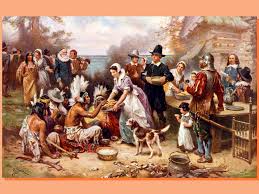Thanksgiving, a cherished American holiday, has deep historical roots that date back to the early 17th century.
This annual celebration revolves around a spirit of gratitude and communal sharing, with a rich history that has evolved over the centuries.
The first thanksgiving: A feast of unity
The origins of thanksgiving can be traced to 1621 when English Pilgrims and Wampanoag Native Americans joined forces for a harvest feast in Plymouth, Massachusetts.
This gathering marked a crucial moment of unity, as the Pilgrims, newcomers to the continent, and the Wampanoag, native to the land, came together to share food, gratitude, and cultural exchange.
Becoming a tradition

Although that first thanksgiving wasn’t an annual event, the idea of setting aside time for gratitude gained traction.
Fast forward to the 19th century, when Sarah Josepha Hale, an influential writer and editor, campaigned for a national day of thanks.
Her efforts bore fruit when, in 1863, President Abraham Lincoln proclaimed Thanksgiving a national holiday.
Thanksgiving’s formal recognition
President Lincoln’s proclamation set the stage for thanksgiving to become an official and recurring part of the American calendar.
The proclamation designated the fourth Thursday of November as the day of celebration, solidifying thanksgiving as a nationwide tradition.
Thanksgiving in the face of adversity: The great depression

The history of thanksgiving is not without challenges. During the Great Depression in the 1930s, President Franklin D. Roosevelt faced pressure to extend the Christmas shopping season by moving thanksgiving to an earlier date.
The decision sparked controversy, with many resisting the change. In 1941, the U.S. Congress officially established thanksgiving as the fourth Thursday in November, ending the uncertainty and cementing its place in the American holiday calendar.
Thanksgiving’s evolving traditions: From rituals to football
Over the years, thanksgiving has evolved beyond its historical roots.
While the core theme of gratitude remains, the way Americans celebrate has transformed.
From traditional family feasts to modern practices like watching football games and participating in Black Friday shopping, thanksgiving has become a multifaceted holiday.
Culinary traditions: Turkey, pumpkin pie, and more

Central to the thanksgiving celebration is the iconic Thanksgiving meal.
Turkey takes the spotlight, accompanied by stuffing, mashed potatoes, cranberry sauce, and pumpkin pie.
These culinary traditions have become synonymous with the holiday, bringing families and friends together around the table.
Thanksgiving today: A blend of tradition and modernity
In contemporary times, thanksgiving continues to be a time for reflection, gratitude, and togetherness.
Families gather, expressing thanks for the blessings of the year.
Volunteer work and community service have also become integral parts of the holiday, emphasizing the spirit of giving back.
Conclusion
The history of thanksgiving is a tapestry woven with threads of unity, gratitude, and resilience.
From its humble beginnings in 1621 to its formal recognition as a national holiday, thanksgiving has stood the test of time.
As families and friends come together each year, the essence of this holiday remains unchanged—a time to give thanks for the blessings of the past and the promise of the future.








